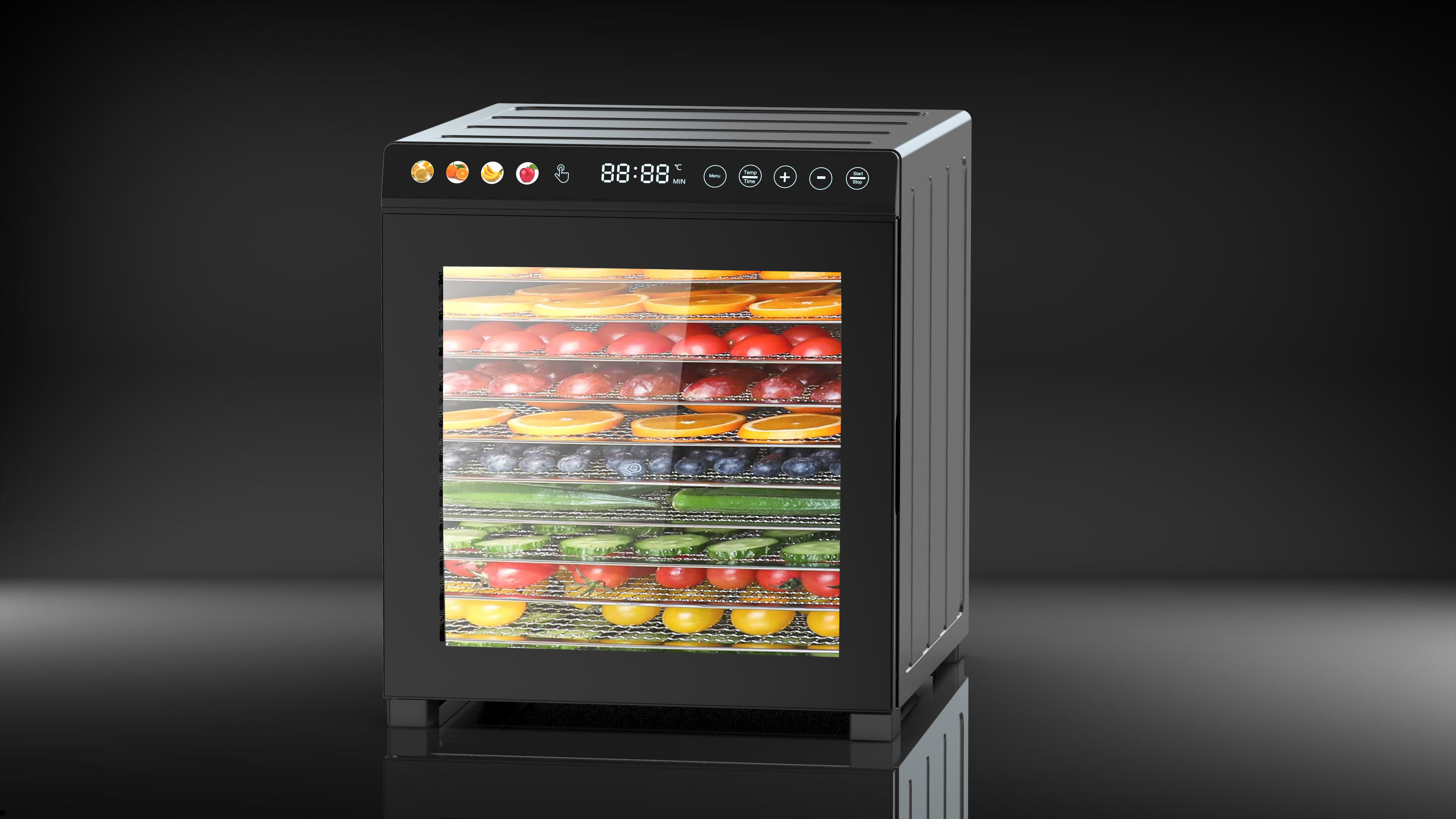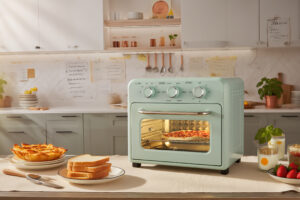Meta Title: Air Fryer Oven vs. Traditional Oven: Cost-Effective Cooking in 2025
Meta Description: Discover why air fryer ovens are more cost-effective than traditional ovens for long-term savings. Explore energy efficiency, versatility, and more.
Permalink: /air-fryer-oven-vs-traditional-oven-cost
As the Sales Manager at Foshan Linden Intelligent Appliances Co., Ltd., I’m passionate about helping families make smart kitchen investments. Our 12L, 16L, and 30L air fryer ovens are designed to deliver top performance while keeping costs low. A question I hear often is: Are air fryer ovens really more cost-effective than traditional ovens in the long run? The answer is a resounding yes, and I’m excited to share why. From energy savings to versatility, I’ll break down how our air fryer ovens save you money over time compared to traditional ovens. Let’s dive into the numbers and benefits to see why air fryer ovens are the budget-friendly choice for 2025!
Why Cost-Effectiveness Matters in Kitchen Appliances
Cooking at home should be delicious and affordable. With rising energy costs and busy lifestyles, choosing the right appliance can impact your wallet significantly. At Foshan Linden, we craft our air fryer ovens to balance performance with efficiency. This article compares air fryer ovens and traditional ovens, focusing on long-term cost savings through energy use, maintenance, and versatility. Whether you’re roasting vegetables or baking bread, I’ll show you why air fryer ovens are the smarter financial choice.
What Is an Air Fryer Oven?
An air fryer oven uses rapid hot air circulation to cook food, mimicking the crispy results of deep frying with minimal oil. Our 12L, 16L, and 30L models combine air frying, baking, roasting, and dehydrating functions. They’re compact, versatile, and designed for efficiency, making them ideal for modern kitchens.
What Is a Traditional Oven?
A traditional oven, whether gas or electric, uses radiant heat to cook food. These large appliances are staples for baking, roasting, and broiling but often come with higher energy and maintenance costs. Let’s explore how they compare to air fryer ovens in terms of long-term savings.
Energy Efficiency: The Core of Cost Savings
Energy consumption is a major factor in long-term cost-effectiveness. Let’s compare how these appliances stack up.
Air Fryer Oven: Lower Energy Consumption
I’ve seen our air fryer ovens work wonders for energy-conscious households. They typically use 1200–1800 watts but cook faster due to their compact size and rapid air technology. For example, a 16L air fryer oven can roast a chicken in 30 minutes at 375°F, using about 0.9 kWh. According to Energy Star, smaller appliances like air fryer ovens can save up to 50% more energy than traditional ovens for similar tasks.
The smaller cooking chamber heats up quickly, requiring no preheating in most cases. This efficiency reduces energy waste, lowering your electricity bill over time. For families cooking daily, these savings add up significantly.
Traditional Oven: Higher Energy Use
Traditional electric ovens use 2000–5000 watts, and gas ovens consume fuel plus electricity for fans and controls. Preheating alone can take 10–15 minutes, using 0.5–1 kWh before cooking begins, per CNET. Baking a casserole for an hour at 350°F might consume 2–3 kWh, far more than an air fryer oven.
Large ovens lose heat through their spacious interiors, increasing energy use. For small meals, this inefficiency is particularly noticeable, making traditional ovens less cost-effective for everyday cooking.
Energy Efficiency Verdict
Air fryer ovens are far more energy-efficient. Their compact design and faster cooking times save electricity, making them a budget-friendly choice for long-term use.
Cooking Speed: Time Is Money
Faster cooking means less energy used, translating to cost savings. Let’s see how these appliances compare.
Air Fryer Oven: Quick and Efficient
Our air fryer ovens are built for speed. The rapid air circulation cooks food up to 30% faster than traditional ovens, according to Good Housekeeping. For instance, a 12L air fryer oven can bake potatoes in 20 minutes, compared to 45–60 minutes in a traditional oven.
This speed reduces energy consumption and saves time, which is invaluable for busy families. Our 30L model handles larger meals just as quickly, making it perfect for batch cooking without breaking the bank.
Traditional Oven: Slower and Costlier
Traditional ovens require longer cooking times due to their size and slower heat distribution. Preheating alone adds significant time and energy costs. Roasting vegetables might take 40 minutes, using more electricity or gas than an air fryer oven for the same result.
Cooking Speed Verdict
Air fryer ovens win for speed, reducing energy use and freeing up time. This efficiency makes them more cost-effective for daily meals.
Versatility: Getting More for Your Money
Versatility maximizes an appliance’s value, reducing the need for additional equipment. Let’s compare their capabilities.
Air Fryer Oven: A Multi-Tasking Marvel
I’m proud of how versatile our air fryer ovens are. They air fry, bake, roast, and dehydrate, covering a wide range of cooking needs. For example, our 16L model can air fry chicken wings, bake a cake, or dehydrate fruit for snacks, all in one appliance. This multifunctionality eliminates the need for separate fryers, ovens, or dehydrators, saving you money on extra purchases.
The ability to customize settings ensures perfect results for various dishes, from crispy fries to tender roasts. This versatility makes our air fryer ovens a cost-effective investment for families.
Traditional Oven: Limited Functionality
Traditional ovens excel at baking and roasting but lack the ability to air fry or dehydrate. For specialized tasks like creating crispy textures with minimal oil, you’d need additional appliances, increasing costs. While traditional ovens handle large meals well, they’re less efficient for small portions, per The Kitchn.
Versatility Verdict
Air fryer ovens offer greater value through their multi-tasking capabilities. They reduce the need for other appliances, making them more cost-effective in the long run.
Maintenance and Durability: Long-Term Savings
Maintenance costs and appliance lifespan impact overall value. Let’s see how these appliances fare.
Air Fryer Oven: Low Maintenance, High Durability
Our air fryer ovens are designed for easy upkeep. Nonstick baskets and dishwasher-safe parts make cleaning a breeze, reducing wear and tear. The compact design minimizes mechanical issues, and our high-quality materials ensure durability. With proper care, our models last years, providing excellent value.
Maintenance costs are low, as there’s no need for specialized cleaning products or frequent repairs. This reliability saves money over time.
Traditional Oven: Higher Maintenance Costs
Traditional ovens, especially gas models, require regular maintenance, such as cleaning burners or checking heating elements. Repairs can be costly, with replacement parts averaging $100–$500, per HomeAdvisor. Large interiors also accumulate grease, requiring more cleaning effort and products.
Maintenance Verdict
Air fryer ovens are easier and cheaper to maintain. Their durability and low upkeep make them a cost-effective choice for long-term use.
Initial Cost vs. Long-Term Savings
While initial costs matter, long-term savings are key. Let’s compare the upfront investment.
Air Fryer Oven: Affordable and High-Value
Our 12L and 16L air fryer ovens are priced competitively, often between $100–$200. The 30L model, designed for larger families, offers premium features at a slightly higher cost. The energy savings, versatility, and low maintenance quickly offset the initial price, making them a smart investment.
Traditional Oven: Higher Upfront and Ongoing Costs
Traditional ovens, especially built-in or high-end models, can cost $500–$3000. Gas ovens also require installation and fuel costs. Combined with higher energy and maintenance expenses, they’re less cost-effective over time, especially for small households.
Cost Verdict
Air fryer ovens have a lower initial cost and deliver greater savings through efficiency and versatility. They’re the budget-friendly choice for most homes.
Health Benefits: Saving on Nutrition
Healthy cooking can reduce long-term healthcare costs. Let’s explore how these appliances contribute.
Air Fryer Oven: Healthier Meals, Lower Costs
Our air fryer ovens use up to 85% less oil than traditional frying, per Healthline. This reduces fat and calorie intake, promoting better health. Healthier eating can lower risks of diet-related issues, saving on medical expenses over time.
Traditional Oven: Healthy but Less Versatile
Traditional ovens support healthy baking and roasting but can’t replicate air frying’s low-oil crispiness. You may need additional appliances for healthier cooking methods, increasing costs.
Health Verdict
Air fryer ovens promote healthier meals, potentially reducing long-term healthcare costs. Their versatility makes healthy cooking more accessible.
Design and Aesthetic Appeal
At Foshan Linden, we prioritize style. Our air fryer ovens feature sleek designs and warm color tones, enhancing kitchen aesthetics. Traditional ovens, often bulky or built-in, may not blend as seamlessly. For style-conscious households, our models add value without extra cost.
Final Thoughts: Why Air Fryer Ovens Save More
Air fryer ovens are the clear winner for long-term cost-effectiveness. Our 12L, 16L, and 30L models at Foshan Linden offer energy efficiency, versatility, and low maintenance, saving you money on electricity, additional appliances, and repairs. They cook faster, use less oil, and deliver delicious results, making them ideal for budget-conscious families.
Traditional ovens, while reliable for large meals, come with higher energy and maintenance costs, making them less economical for daily use. As an expert in kitchen appliances, I’m confident our air fryer ovens provide unmatched value. Visit www.lindensmart.com to explore our range and start saving with smarter cooking today!




